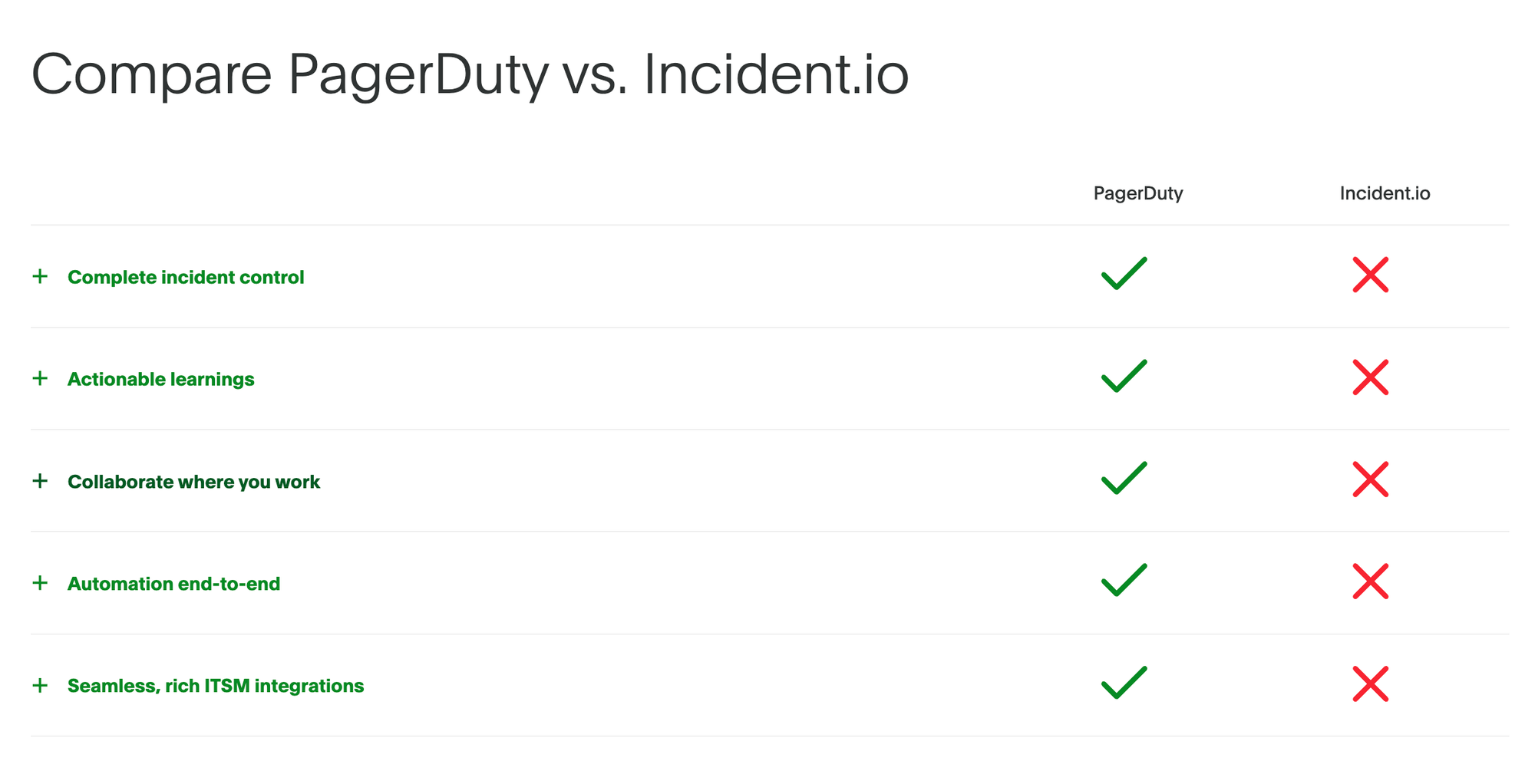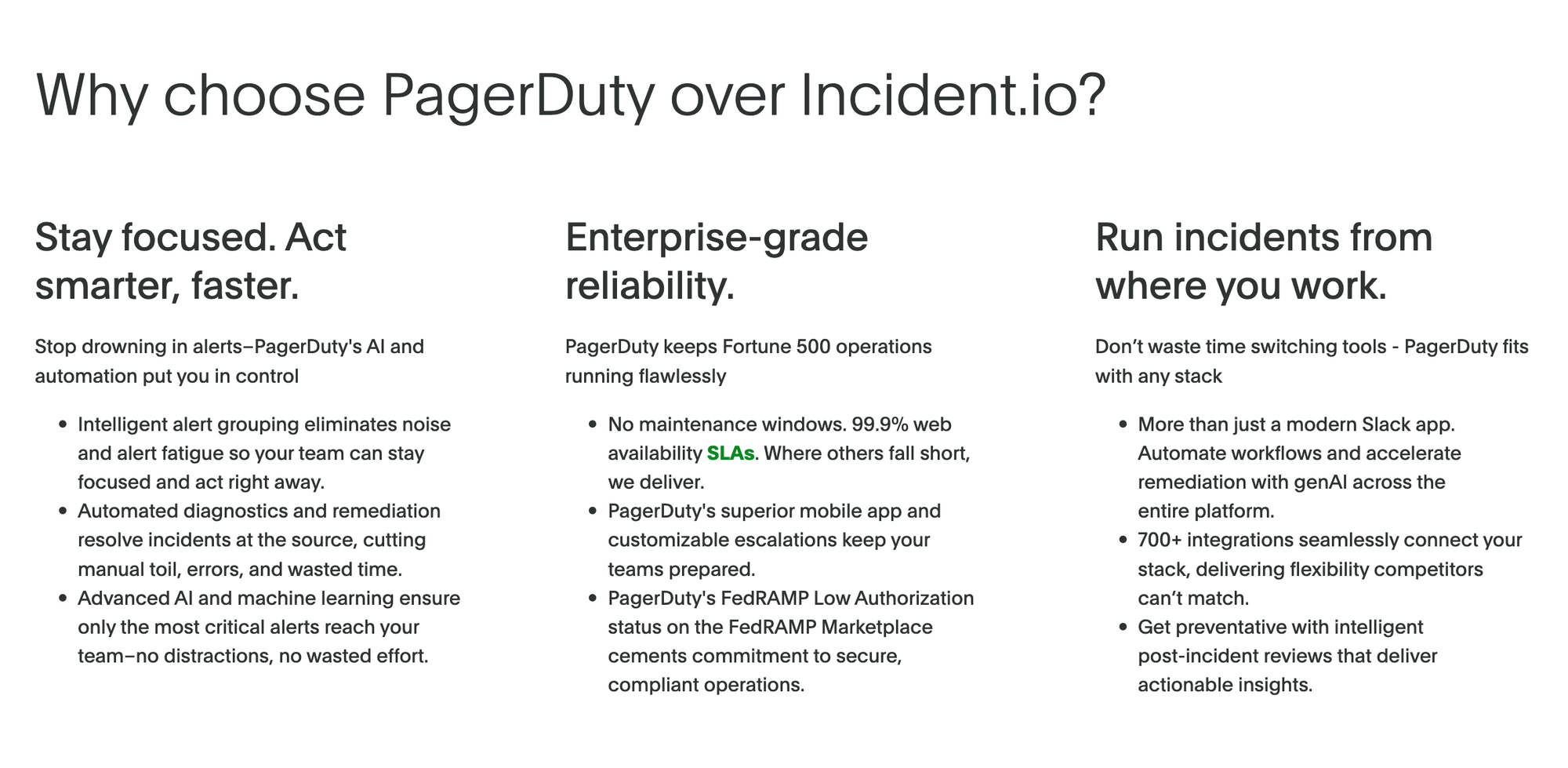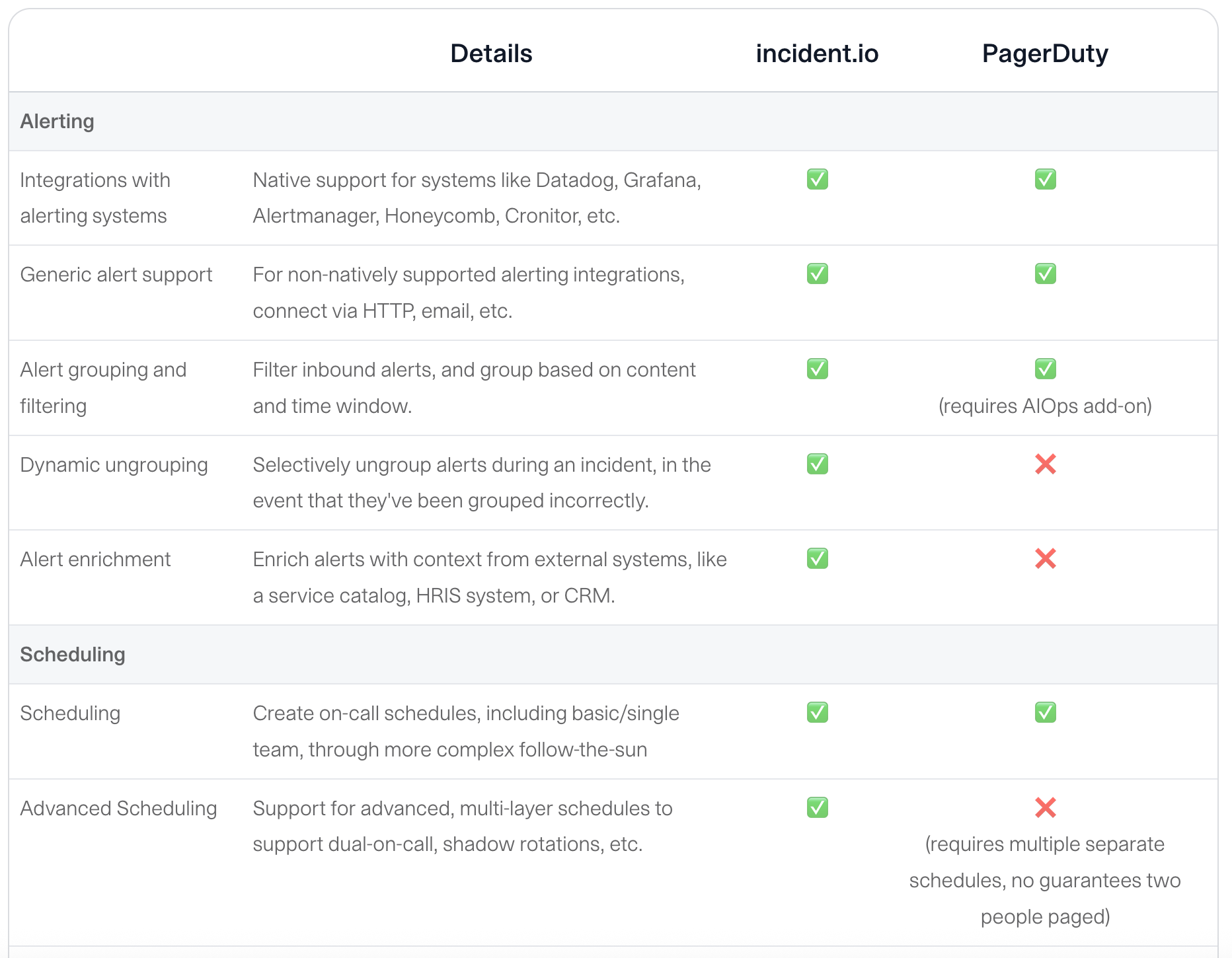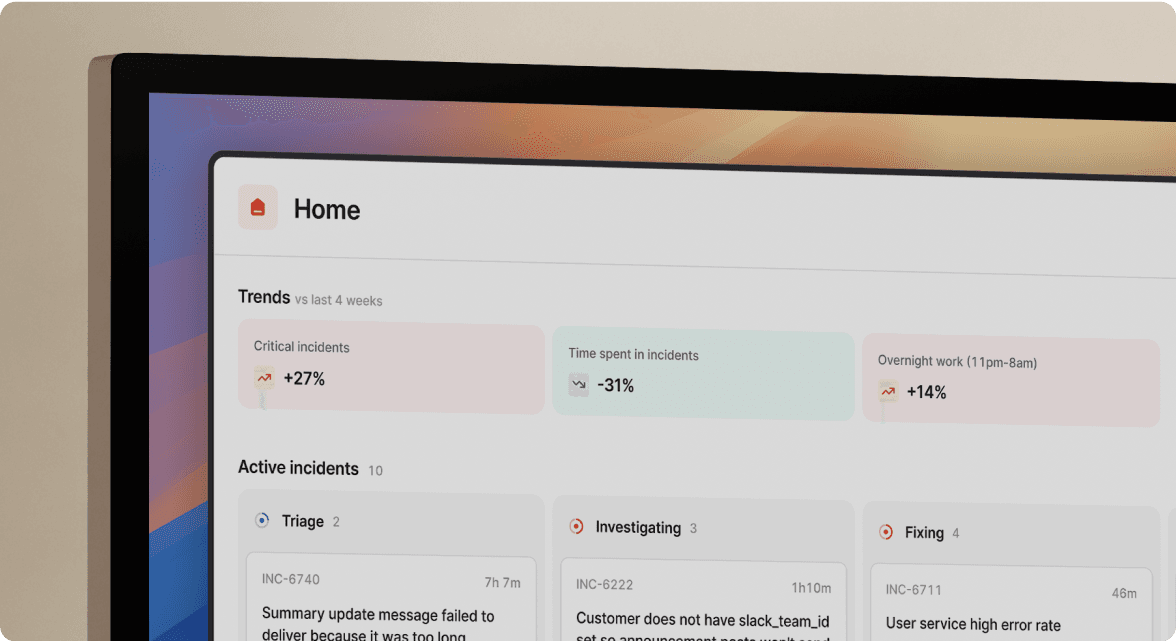Comparing the incident.io vs PagerDuty comparison pages

PagerDuty recently published a new comparison page against incident.io. We have one of those as well.
TL;DR we come from different places
The fundamental difference between incident.io and PagerDuty isn't about feature checkboxes. It's about philosophy:
- PagerDuty started as an alerting and on-call tool, adding incident management features over time
- incident.io started as an incident management platform that added on-call capabilities
This leads to very different user experiences and approaches to managing incidents.
Why these comparison pages exist
Why do marketers like me create competitor comparison pages like these? Primarily for Search Engine Optimization. When potential customers type "incident.io vs PagerDuty" into Google, both companies want to be the one providing the answer. It's standard practice in B2B SaaS marketing.
What's interesting about PagerDuty's comparison page is that it appears solely for SEO purposes. I can't find a link from their main site navigation, product pages, or resources section.
Respect where it's due: PagerDuty pioneered the category
Before I dive into the comparison pages, let's give credit where it's due: PagerDuty essentially created the on-call category. They've been around since 2009, solving the critical problem of alerting and on-call management well before many of us thought about it. They pioneered how engineering teams get notified when things break, and the entire industry owes them a debt of gratitude.
That's why it's particularly surprising to see misrepresentations of a company that came along later with a different focus. With such a strong legacy, there wouldn't be a need to stretch the truth.
Let's start with what PagerDuty says we don't do
Looking at PagerDuty's comparison chart, you'd think incident.io was just a plucky on-call startup with a Slack integration. According to their comparison chart, here are all the things we apparently can't do:

These claims are inaccurate with the following two statements being particularly misleading:
"Enterprise-grade platform that delivers end-to-end incident management capabilities"
"Beyond on-call: automates workflows across the full incident lifecycle"
This characterization is simply incorrect. Our entire platform was built around being an end-to-end incident management solution. PagerDuty was primarily an on-call tool that added incident management features over time while we built ours from the ground up.
The Intercom engineering team might be surprised to learn we don't do end-to-end incident management, considering they said:
Jumping between multiple tools during high-pressure incidents was challenging. Now everything is centralized in incident.io, simplifying incident response significantly. Brian Scanlan, Senior Principal Engineer, Intercom
Comparison charts like this, where one vendor does everything and the other does nothing, don't provide real value to readers. However, the inaccuracies didn't stop with the comparison chart. Earlier on the page, PagerDuty highlights three reasons for choosing them over incident.io.
Let's examine each of them.

The AI capabilities
"Stay focused. Act smarter, faster. Stop drowning in alerts–PagerDuty's AI and automation put you in control."
Of course, PagerDuty is working on AI projects. Every company is working on AI projects. But this statement doesn't acknowledge that incident.io also has significant AI capabilities.
At incident.io, we've built AI capabilities that enhance the incident response process. Today, you'll get real-time note-taking during incidents with our Scribe AI and natural conversation with your incident platform, where you can ask questions, draft customer communications, and log follow-up actions conversationally.
We're also working on a new product called Investigations, where we analyze your code, logs, monitoring tools, and thousands of past incidents to identify what's broken, why, and how to fix it. We're making steady progress on this new product, and it shows significant promise.
The integrations comparison
Another statement from their comparison page:
"Run incidents from where you work. Don't waste time switching tools - PagerDuty fits with any stack"
PagerDuty correctly notes that they have 700+ integrations, which is impressive and the result of being in the market since 2009.
What's worth considering is that while they have many integrations, the most important ones are those that connect to the tools companies actually use daily. incident.io integrates with all the modern tools that companies care about including every major issue tracker, service catalog tool, alerting platform, and collaboration system.
The difference isn't about quantity, it's about quality and depth. Our integrations are built specifically for modern incident management.
Added 5/15/25. This section deserved more depth.
For example, our Github integration.
Unlike PagerDuty's one-way integration, incident.io creates bidirectional links between incidents and code. By automatically commenting on GitHub PRs with links back to incidents, we make sure the context behind each code change remains permanently accessible in your repository's history. Engineers reviewing code months or years later can instantly understand why a particular change was made and what incident prompted it, transforming your Git history into a valuable knowledge base that preserves the reasoning behind technical decisions.
While PagerDuty offers lots of connections, we focus on ensuring our integrations provide substantial value for the tools you use today.
The enterprise capabilities
Lastly, the comparison page states:
"PagerDuty keeps Fortune 500 operations running flawlessly"
This implies incident.io doesn't serve enterprise customers, which would surprise Netflix, Airbnb, Etsy, and our many other enterprise customers.
However, PagerDuty does have FedRAMP compliance, which we don't currently offer. Achieving FedRAMP authorization is no small feat. It requires rigorous security assessments, continuous monitoring, and a significant investment of time and resources. For companies in the federal space who require FedRAMP compliance, PagerDuty is indeed the better option between us.
What our comparison page says
On our comparison page, we're clear about where PagerDuty excels: they've been around longer, they have a larger customer base, and they have more out-of-the-box integrations which does benefit some companies. We give credit where it's due.
We also highlight our strengths: an intuitive user experience, built-in postmortem templates, powerful workflows, and comprehensive end-to-end incident management.
One key differentiator we detail is our Catalog. It's a core component of the incident.io platform and embodies our approach to whole-organization incident response. It lets you bring in teams and users, connect your CRM to provide context on customers, and integrate with existing tooling like issue trackers and code repositories to enhance your incident response.
PagerDuty's catalog places restrictions on how business services can be defined and structured. Users often need to work around these limitations, like treating a team as a service or adding important details to description fields because the structure is constraining.
Our comparison chart gives PagerDuty credit for its strengths while also highlighting where we believe incident.io offers advantages:

What customers are saying about PagerDuty
For the past 8 months, we've been documenting feedback about PagerDuty during customer calls. Here are the three most common themes we hear, directly in the words of customers and prospects:
Cost Concerns and Pricing Structure
Many customers express concerns with PagerDuty's costs, particularly when comparing the price to the features they use. There's dissatisfaction with the pricing model, especially regarding additional charges for features that customers consider basic.
"It's crazy, what they make you pay for what they're offering."
User Interface and Experience Issues
Customers frequently mention that PagerDuty's user interface feels outdated and difficult to navigate. Many users find the platform unintuitive, particularly for scheduling and overrides.
"The UI of PagerDuty hasn't changed for I don't know a decade."
Lack of Innovation and Feature Development
Many customers perceive PagerDuty as not evolving significantly over time. They express frustration with the slow pace of improvements despite increasing costs.
"I will not go into expletives of how bad PagerDuty is as I'm sure you are aware."
One last thing
If you're evaluating incident management platforms, look beyond marketing comparison charts (yes, even ours) and talk to actual users. Try both platforms. See which one feels more intuitive and meets your needs.
And for PagerDuty's product marketing team: it's incident.io. Not Incident.io :)

See related articles
So good, you’ll break things on purpose
Ready for modern incident management? Book a call with one of our experts today.

We’d love to talk to you about
- All-in-one incident management
- Our unmatched speed of deployment
- Why we’re loved by users and easily adopted
- How we work for the whole organization



